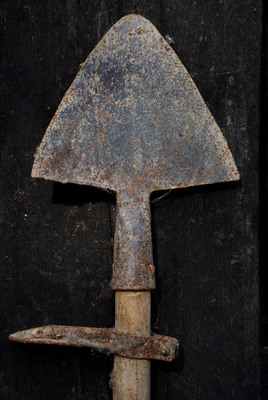By Sean Conway

Garden tools once came in a vast array of task-specific shapes and sizes. These tools can still be found at tag sales, antique malls and junk stores, and they're surprisingly easy to spruce up and use again.
After gardening for decades, I have learned that what separates efficient work from drudgery is having the right tools for the job.
The problem with many tools today is that they weren't designed with specific tasks in mind. They are generalists of sorts, and their design suggests that more attention was paid to how well they nest together in a shipping container than to how well they perform a task.
You will search in vain at the big box stores and home-and-garden centers for once-common tools such as asparagus knives, long-poled apple pickers, carrot digging spades and manure forks.
And the shovels available today all seem to have the same basic shape, unlike the vast array of task-specific shovels once available to gardeners. At one time gardeners could choose from sharp edged spades, designed for easier planting, narrow spades for digging trenches, wide scooped shovels for moving light materials, long handled shovels, short handled shovels, flat shovels and pointed shovels.
It is still possible to find some of these well-designed tools from days gone by. Tag sales, antique malls and second-hand shops often have wonderful selections of old tools, and with a little TLC you can restore them to good working condition.
Metal surfaces should be cleaned with sand paper to remove built up rust, then rubbed with an oil-soaked cloth. Edges can be filed to restore sharpness, and cracked handles filled with wood glue and sanded or replaced if the cracks run too deep.
After use, all tools should be cleaned to remove excess dirt, sap or shavings. Metal parts should be rubbed with an oily cloth, or dipped into a bucket filled with sand that has been soaked with oil.
Removing debris from metal parts and coating metal with a film of oil will prevent new rust from forming and keep your tools in top working condition.
This is not to suggest that the only good tools are old tools. Gardeners continue to innovate, and tool design has evolved apace. There are some new tools out that you should consider adding to your tool shed this spring.
Recently on "Cultivating Life" we tested a few new tools that I hadn't seen before, but that I am planning on adding to my collection.
The broadfork is a double-handled digging fork used for turning over garden soil. Two wooden handles are attached to a flat metal bar with four long tines extending from it. Positioning the fork with the handles, you step on the flat bar, drive the tines into the soil and pull back on the handles. The length of the handles provides tremendous leverage and easily moves the tines through the soil. This tool is also perfect for digging up root vegetables.
The right-angle trowel is another impressive tool I had not seen before. The blade of this unusual looking trowel is perpendicular to the handle. It looks a bit odd at first, but after using it for a few minutes, I was hooked. The design is reported to reduce wrist strain, and I can see why.
For gardeners with large gardens, or a lot of planting to do, the Hatfield transplanter is a wonderful tool that not only saves time but also one's back. This tool makes it possible to plant small transplants or bulbs quickly and efficiently without having to bend over.
Between old tools that were designed for specific tasks and these new tools with their ergonomic designs, working in the garden is much more efficient.
© Cultivating Life by Sean Conway
AUTOS | HOBBIES | EDUCATION | FAMILY | FASHION | FOOD & RECIPES | HOME DECOR | RELATIONSHIPS | PARENTING | PETS | TRAVEL | WOMEN
Home & Garden - In Praise of Good Old Garden Tools and a Few New Ones